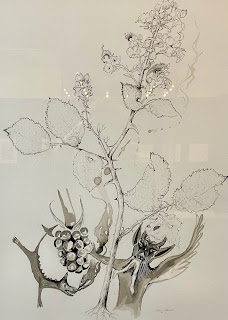Last weekend I visited the North Lincolnshire Museum to see 'The New Folk', an exhibition based on North Lincolnshire's folkloric customs.
The exhibition was curated by Kat Spence, Lucy Bowley and Sam De Freitas, and even though each of the artists' unique responses to the theme is celebrated, there is a definite sense of cohesion and unity.
The graphic design for the exhibition was created by Melody Phelan-Clark.
(I loved the bold, almost stained glass quality of the graphics, which helped to present the traditional folkloric subject matter in a more contemporary, immediate manner.)
It was so interesting to see how these beliefs and traditions from the past were interpreted to become so resonant in these present times.
Fauna And Familiars.
Jane Barnett.
Barnett's tactile sculptures were so characterful and communicated both the sinister and comical, playful aspects of these mythical creatures.
'The Witch Hare' is presented as a shape-shifter, part creature and part human.
I was fascinated by his teeth and the workmanship is absolutely incredible.
'The Rutterkin Cat' is based on a familiar owned by the Witches Of Belvoir, a family of 17th Century witches who lived in Lincolnshire.
(I'm not sure what this cat is up to, but it look a bit suspicious to me!)
Spells And Stones.
Robyn Lawrence.
'Folke -'.
This series of ink and graphite illustrations communicates the protective powers of the hag stone.
The drawings are so detailed and delicate, it was difficult to capture the quality of the drawing with my camera, (apologies), but it was so impactful to see them displayed together.
These intimate studies seemed to become powerful talismans grouped together en masse.
Protection And Loss.
Sophie Ferrier.
'Guardians of The Soil'.
Including textile work by Dan Lee and masks made by Holland Otik.
The four Guardians: Fungi, Mulch, Fauna and Seeds perform a ritual based on traditional folk lore practices. They want to warn us of the devastation caused by intensive farming and beg us to repent.
Chants of 'in soil we trust' fill the exhibition space, their lament becomes hypnotic and mournful, as they rake the soil with their bare hands.
Plants And Properties.
Felicity Tattersall.
'Fern'. 'Cowslip.' 'Bramble.'
Tattersall's delicate and ethereal pen and ink depictions of fern, cowslip and bramble explore their prized medicinal properties.
They also suggest the magical elements that were intertwined with the curative properties that were so relied upon in the past.
Burial And Ritual.
Layan Harman.
'The Hamburg Hill Burial Assemblage'.
Harman's hand-made burial outfit consists of a nettle hat, feather cape (made from moulted feathers collected over several years),copper gloves, bronze knife and nettle shoes.
It was amazing to see the vast array of technical skills that had been incorporated, including hand forging, weaving, textiles and dyeing.
However, the outfit isn't only an incredible example of historical research and craftsmanship, it seems to take on a shamanic-type of character all of its own that resides over the exhibition.
Travel And Change.
Matt Feldman.
'Walking Through Dark Arches.'
Feldman has blended archival footage and field recordings to produce a haunting 'audio collage' that tracks the evolution of the traditional Irish folk song 'The Unfortunate Rake'. This then became 'The Cowboy's Lament' in the American West, as people migrated towards the gold mines to seek their fortune, then evolving again to become 'The Streets of Laredo'.
This audio track poignantly communicates how songs from the past not only transmute through the generations, but transcends continents.
The crackling soundscape of damaged archival records, combined with the faint singing of past folk songs blends with the Guardians' chanting from Ferrier's haunting film, to create the perfect soundtrack for this exhibition.




























I like the Black Shuck, very creepy and sort of draws you in :)
ReplyDeleteHe was one of my faves too, I was obsessed with his amazing teeth! x
Delete